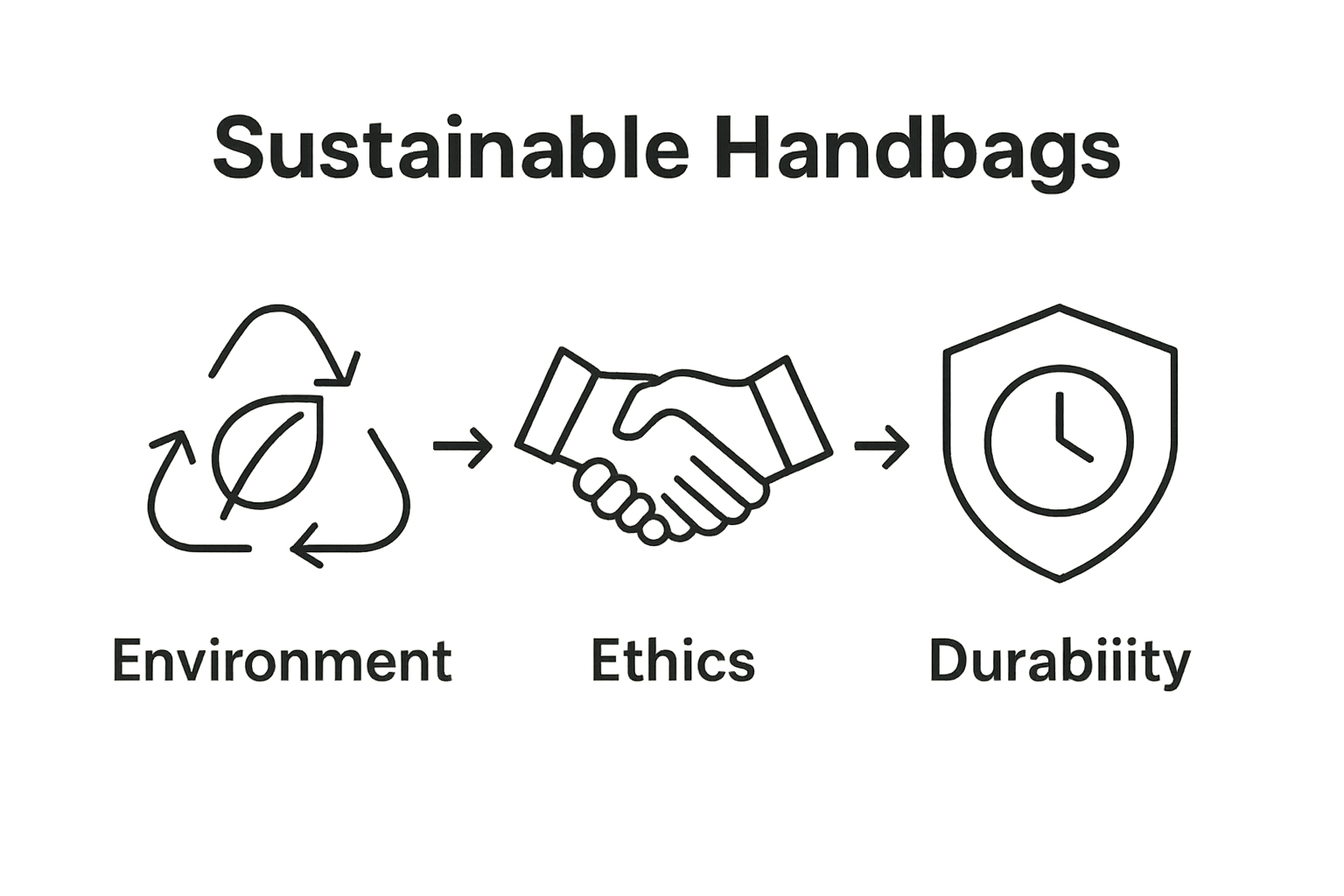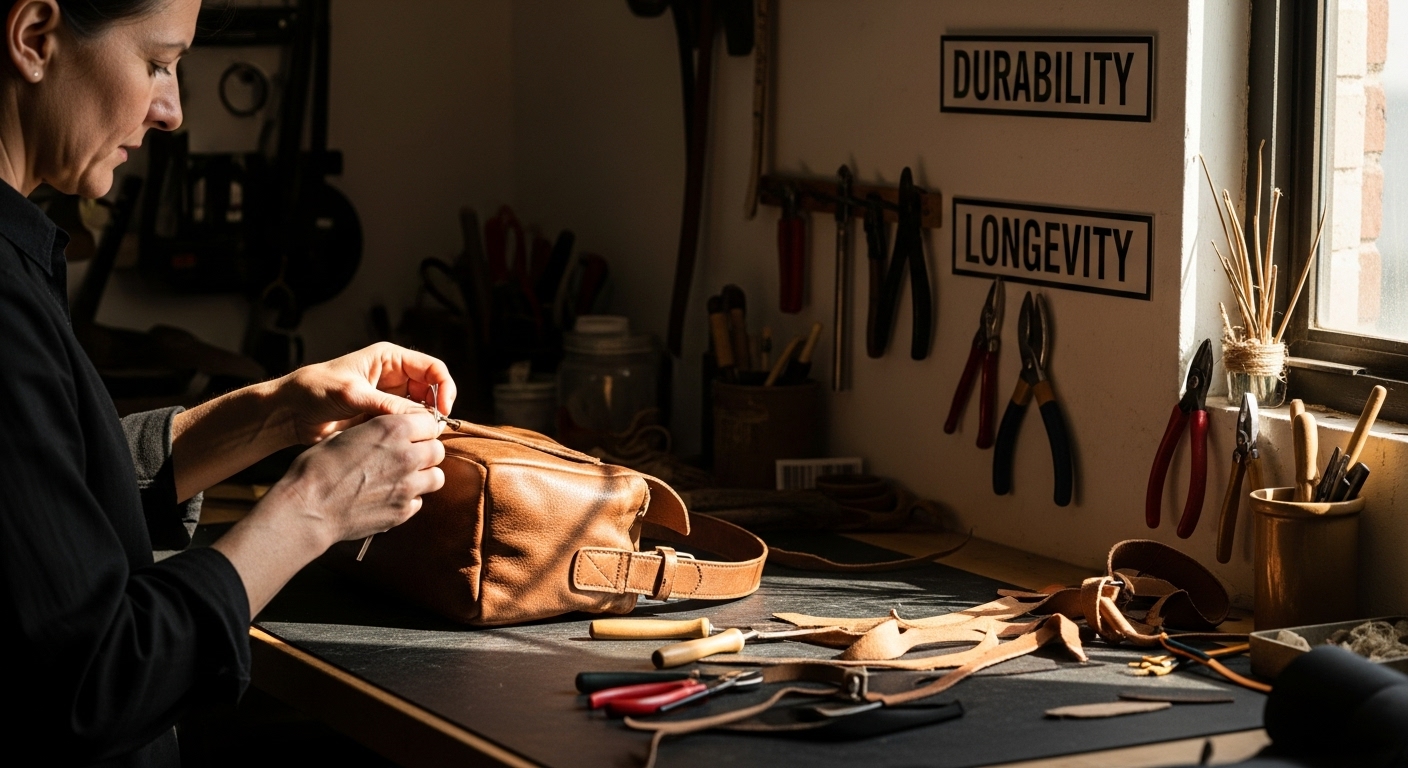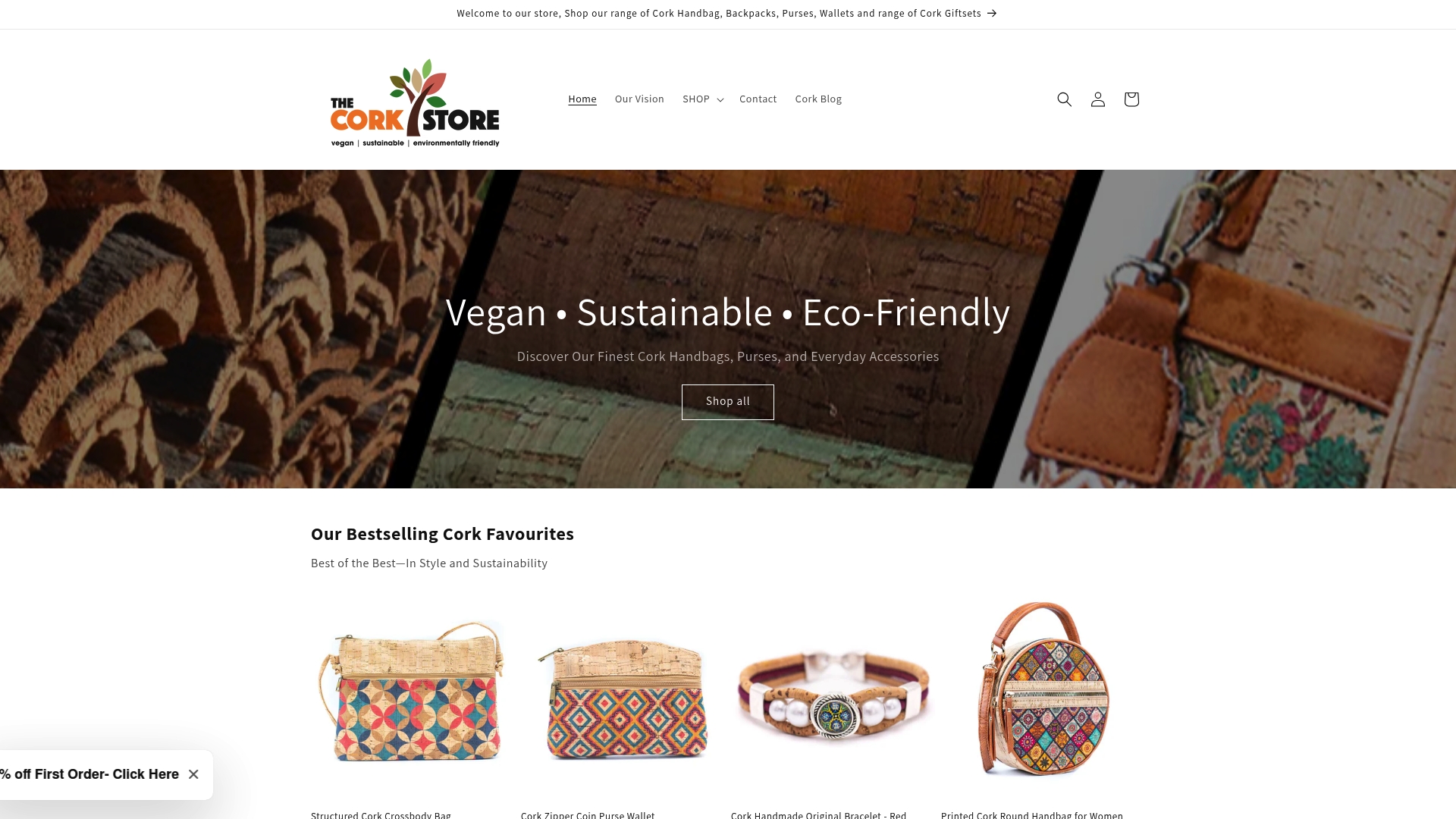
Understanding the Qualities of Sustainable Handbags
Share
Sustainable handbags are quietly taking over the fashion world. It sounds bold but the global market for sustainable fashion is set to reach £36 billion by 2025. Most people get swept up by trendy designs or catchy eco-labels. The real surprise is that genuine sustainability is not just about the materials you can see but the entire journey from raw fibre to finished bag and even how it returns to nature.
Table of Contents
- Defining Sustainable Handbags: What Are They?
- The Importance of Material Choices in Sustainability
- Ethical Production Practices Behind Sustainable Handbags
- Evaluating Durability and Longevity for Eco-Friendly Fashion
- Understanding the Role of Certification in Sustainable Handbags
Quick Summary
| Takeaway | Explanation |
|---|---|
| Sustainable handbags prioritise the environment | They are designed to reduce ecological impact through responsible material sourcing and manufacturing practices. |
| Ethical production is essential | Handbags should be made in fair working conditions, ensuring workers receive living wages and safe environments. |
| Material longevity is crucial | Selecting durable materials that resist wear can extend the lifespan of handbags, promoting sustainable consumption. |
| Certification enhances transparency | Certifications validate sustainable practices, helping consumers make informed choices and ensuring manufacturers adhere to standards. |
| Conscious consumer choices drive change | By purchasing sustainable handbags, consumers can support ethical production and contribute to environmental conservation efforts. |
Defining Sustainable Handbags: What Are They?
Sustainable handbags represent a profound shift in fashion accessory design, moving beyond aesthetic appeal towards comprehensive environmental responsibility. These accessories are crafted with a holistic approach that considers the entire lifecycle of the product, from raw material selection to manufacturing processes and eventual disposal.
The Core Principles of Sustainability
At their essence, sustainable handbags are defined by three fundamental principles: environmental preservation, ethical production, and long-term durability.
 Sustainable design goes far beyond simply using green materials. It encompasses a comprehensive strategy that minimises ecological impact while ensuring social responsibility throughout the production chain.
Sustainable design goes far beyond simply using green materials. It encompasses a comprehensive strategy that minimises ecological impact while ensuring social responsibility throughout the production chain.
Key characteristics of sustainable handbags include:
- Materials sourced from renewable or recycled resources
- Manufacturing processes that reduce carbon emissions
- Minimal waste generation during production
- Fair labour practices and worker welfare
- Potential for product repair, repurposing, or biodegradation
Environmental and Ethical Considerations
The sustainable handbag movement challenges traditional fashion industry practices by prioritising transparency and accountability. By selecting materials like organic cotton, recycled polyester, or innovative plant-based textiles, manufacturers can significantly reduce environmental strain.
Moreover, these accessories often represent a commitment to ethical production. Our guide on vegan handbags explores how cruelty-free alternatives can transform consumer choices, demonstrating that style and sustainability are not mutually exclusive.
Understanding sustainable handbags requires recognising them as more than mere accessories. They are tangible expressions of environmental consciousness, reflecting a growing consumer desire to make responsible, informed purchasing decisions that positively impact our planet.
Below is a table summarising the key characteristics that define sustainable handbags, helping readers easily distinguish the essential features.
| Characteristic | Description |
|---|---|
| Materials | Sourced from renewable or recycled resources |
| Manufacturing Processes | Reduce carbon emissions and generate minimal waste |
| Labour Practices | Fair, safe working conditions and worker welfare |
| Product Lifecycle | Design enables repair, repurposing, or biodegradation |
| Environmental Preservation | Minimises overall ecological impact throughout the supply chain |
| Ethical Production | Upholds social responsibility and transparency |
| Durability | Crafted for long-term use, resisting wear and tear |
The Importance of Material Choices in Sustainability
The materials selected for crafting handbags play a pivotal role in determining their overall environmental impact. Sustainable material choices are not merely about aesthetics or trend, but represent a profound commitment to reducing ecological harm and promoting responsible manufacturing practices.
Understanding Material Lifecycle
Each material used in handbag production carries a unique environmental footprint. Traditional leather production, for instance, involves significant water consumption, chemical treatments, and carbon emissions. In contrast, innovative materials like cork, recycled polyester, and organic plant-based textiles offer transformative alternatives that minimise environmental degradation.
Key considerations in sustainable material selection include:
- Carbon emissions during material extraction
- Water usage in production processes
- Chemical treatments and potential toxic byproducts
- Biodegradability and end-of-life disposal potential
- Renewable or recycled material sources
Environmental and Ethical Implications
Beyond environmental metrics, material choices reflect deeper ethical commitments. Our comprehensive guide on sustainable materials explores how conscious material selection can transform industrial practices. Sustainable materials not only reduce ecological strain but also support fair labour practices, promote worker welfare, and challenge traditional resource-intensive manufacturing models.
Innovative materials like cork demonstrate remarkable potential. Harvested without destroying trees, cork represents a regenerative resource that supports biodiversity, sequesters carbon, and provides economic opportunities for local communities. By prioritising such materials, handbag manufacturers can create products that are both environmentally responsible and socially impactful.
This table compares traditional and sustainable material choices for handbags, highlighting their environmental and ethical considerations for an easy overview.
| Material Type | Environmental Impact | Ethical Considerations |
|---|---|---|
| Traditional Leather | High water usage, chemical treatments, high emissions | Can contribute to animal welfare concerns |
| Recycled Polyester | Lowers carbon emissions, reduces waste | Promotes circular economy |
| Organic Cotton | Reduces pesticide use, less water consumption | Supports sustainable agriculture |
| Cork | Minimal impact; harvested without tree felling | Supports biodiversity and local communities |
| Plant-based Textiles | Biodegradable, renewable resources | Offers cruelty-free alternatives |
Ethical Production Practices Behind Sustainable Handbags
Ethical production transcends mere manufacturing processes. It represents a comprehensive approach to creating accessories that respect human dignity, environmental integrity, and social responsibility throughout the entire supply chain.
Principles of Ethical Manufacturing
Sustainable handbag production is fundamentally rooted in transparent, fair, and humane working conditions. This approach challenges traditional fashion industry practices by prioritising worker welfare, reasonable compensation, and safe working environments. Fair trade certification provides a critical framework for ensuring these standards are consistently maintained.
Key ethical production principles include:
- Guaranteed living wages for all workers
- Safe and hygienic workplace environments
- Prohibition of child labour and forced labour practices
- Freedom of association and collective bargaining rights
- Non-discriminatory employment practices
Social and Economic Impact
Beyond individual worker protections, ethical production practices generate broader societal benefits. These manufacturing approaches create economic opportunities in communities, support skill development, and challenge exploitative industrial models. Our guide on sustainable fashion choices explores how consumer decisions can drive meaningful systemic change.
Ethical production also involves rigorous supply chain transparency. Manufacturers committed to sustainability meticulously track material origins, worker conditions, and environmental impact. This holistic approach ensures that every handbag represents not just a fashion accessory, but a statement of social consciousness and collective responsibility towards global worker welfare and environmental preservation.
Here is a table outlining the main principles of ethical production for sustainable handbags, allowing readers to quickly see key practices and their intended outcomes.
| Principle | Intended Outcome |
|---|---|
| Living Wages | Ensures fair pay and economic security for workers |
| Safe Working Conditions | Protects health and wellbeing of employees |
| No Child or Forced Labour | Upholds human rights and dignity |
| Freedom of Association | Empowers collective bargaining and worker representation |
| Non-discriminatory Employment | Promotes equal opportunity and workplace fairness |
Evaluating Durability and Longevity for Eco-Friendly Fashion
Durability represents a cornerstone of sustainable fashion, transforming handbags from disposable accessories into long-lasting investments. By prioritising quality construction and resilient materials, eco-conscious manufacturers challenge the fast fashion model that promotes frequent replacements and generates significant waste.
Defining Durability in Sustainable Design
Research on sustainable consumption demonstrates that product longevity directly correlates with reduced environmental impact. Durable handbags minimise resource consumption by extending the useful lifecycle of an accessory, thereby decreasing the frequency of manufacturing processes and subsequent carbon emissions.
Key indicators of handbag durability include:
- High-quality material composition
- Robust stitching techniques
- Resistance to wear and tear
- Potential for repair and restoration
- Timeless design that transcends seasonal trends
Strategies for Maximising Product Lifespan
Sustainable handbag durability extends beyond initial manufacturing. Our comprehensive guide on eco-friendly materials explores how material selection and maintenance practices contribute to prolonged product use. Consumers play a crucial role by selecting versatile designs, performing regular maintenance, and adopting repair-oriented approaches that extend an accessory’s functional life.
By embracing durability as a fundamental principle, sustainable fashion transforms accessories from transient commodities into enduring statements of environmental consciousness.
The following table lists key indicators that contribute to the durability and longevity of sustainable handbags, supporting readers in understanding the aspects of responsible design.
| Durability Indicator | Contribution to Longevity |
|---|---|
| High-quality Materials | Resist damage and wear over time |
| Robust Stitching | Prevents seams from splitting with regular use |
| Wear and Tear Resistance | Maintains appearance and function under daily use |
| Repair Potential | Allows for restoration rather than replacement |
| Timeless Design | Ensures style remains attractive beyond seasonal trends |
 Each carefully crafted handbag becomes a testament to responsible consumption, challenging disposable culture and promoting a more thoughtful relationship with personal style and environmental stewardship.
Each carefully crafted handbag becomes a testament to responsible consumption, challenging disposable culture and promoting a more thoughtful relationship with personal style and environmental stewardship.
Understanding the Role of Certification in Sustainable Handbags
Certification serves as a critical mechanism for validating and communicating sustainable practices within the fashion industry. These standardised frameworks provide transparent, measurable criteria that help consumers make informed purchasing decisions and hold manufacturers accountable for their environmental and ethical commitments.
Principles of Sustainable Certification
International environmental management standards establish rigorous benchmarks for sustainable production. Certification processes evaluate multiple dimensions of manufacturing, including material sourcing, worker conditions, carbon emissions, and waste management. These comprehensive assessments ensure that sustainable handbags meet stringent ecological and social responsibility criteria.
Key certification focus areas include:
- Traceability of raw material origins
- Verification of ethical labour practices
- Measurement of carbon footprint
- Assessment of waste reduction strategies
- Compliance with environmental protection standards
Impact and Consumer Empowerment
Certification transforms abstract sustainability concepts into tangible, verifiable outcomes. Our guide to eco-friendly fashion choices highlights how certification empowers consumers to support responsible manufacturing. By selecting certified sustainable handbags, individuals directly contribute to broader environmental conservation efforts and promote industry-wide transformation.
Moreover, certification systems create a transparent ecosystem that encourages continuous improvement. Manufacturers are motivated to innovate, reduce environmental impact, and develop more sustainable production techniques to maintain their certified status. This dynamic approach ensures that sustainable fashion remains a progressive, evolving field committed to meaningful ecological and social change.
This table summarises the main focus areas considered during sustainable certification of handbags, clarifying the multi-faceted criteria for readers seeking trustworthy products.
| Certification Focus Area | Purpose |
|---|---|
| Material Traceability | Confirms origin of raw materials |
| Ethical Labour Verification | Ensures workers are treated fairly |
| Carbon Footprint Measurement | Assesses greenhouse gas emissions throughout production |
| Waste Reduction Assessment | Evaluates strategies for minimising manufacturing waste |
| Environmental Compliance | Checks adherence to protection laws and sustainable practices |
Make Sustainable Handbags Part of Your Everyday Style
Are you searching for accessories that truly reflect your commitment to sustainability? The article highlights how most handbags miss the mark when it comes to ethical production, responsible materials, and genuine longevity. With so many brands overlooking eco-friendly and cruelty-free standards, it can be hard to find options that meet both your values and your style goals.

At The Cork Store, you will discover a carefully curated collection of sustainable handbags crafted from premium cork material. Every item embodies the durability, environmental consciousness and ethical manufacturing principles explained in our guide to sustainable materials. Experience eco-luxury without compromise. Take the next step toward sustainable fashion by exploring our full range at https://thecorkstore.co.uk. Shop now to express your values through timeless, animal-friendly style.
Frequently Asked Questions
What defines a sustainable handbag?
Sustainable handbags are defined by their commitment to environmental preservation, ethical production, and long-term durability. They are made from renewable or recycled materials, use eco-friendly manufacturing processes, and prioritise fair labour practices.
What materials are commonly used in sustainable handbags?
Common materials for sustainable handbags include organic cotton, recycled polyester, cork, and innovative plant-based textiles. These materials reduce ecological impact and can often be sourced sustainably or from renewable resources.
How does durability affect the sustainability of handbags?
Durability is crucial for sustainable handbags as it extends their lifespan and reduces the need for frequent replacements. Durable handbags are typically made from high-quality materials and feature robust construction, which minimise resource consumption and environmental impact over time.
What role does certification play in sustainable fashion?
Certification provides a reliable mechanism to validate sustainable practices in handbag production. It ensures that manufacturers meet specific criteria related to material sourcing, ethical labour conditions, and environmental impact, empowering consumers to make informed choices.
Recommended
- 7 Top Eco Handbags for Sustainable Fashion Lovers – The Cork Store
- Understanding What Makes Vegan Handbags Eco-Friendly – The Cork Store
- Understanding Why Buy Vegan Bags for Sustainable Fashion – The Cork Store
- Understanding the Features of Vegan Purses – The Cork Store
- Understanding How Italian Handbags Are Made – San Rocco Italia
- Sustainable fashion Archives - Maker of Jacket
